Public energy company: strategic outline case
Independent strategic outline case to consider how Scotland's public energy company could be developed suggests that a phased approach would work better.
2. Strategic Case
2.1 Introduction
There are approximately 2 million domestic gas customers and 2.4 million domestic electricity customers in Scotland.[2] However, the energy market does not always meet the needs of these customers. In particular:
- Energy prices for consumers remain high [3]
- Many consumers do not switch to better deals, even though these are available
- Fuel poverty remains a key issue in Scotland.
Although many of the powers relating to energy supply are reserved to Westminster, SG has set out its own vision for the energy sector in Scotland. In December 2017, SG published the Scottish Energy Strategy: The future of energy in Scotland ("the strategy"). The objectives of the strategy are set out below.
Table 4 - SG 2050 vision for energy in Scotland
| Theme |
Description and Targets |
|---|---|
| A whole system view |
|
| An inclusive energy transition |
|
| A smarter model for local energy provision |
|
Source: Scottish Government (2017), Scottish Energy Strategy: The future of energy in Scotland
SG has also designated energy efficiency as a national infrastructure investment priority and is developing Scotland Energy Efficiency Programme (SEEP) to deliver this. This will build on the range of existing interventions, including:
- Home Energy Efficiency Programmes for Scotland (HEEPS)[4]: This programme includes funding for area-based schemes, where the SG provides funding to LAs to develop and deliver fuel poverty programmes (mainly solid wall insulation) in areas with high levels of fuel poverty and also Warmer Homes Scotland, the national fuel poverty programme delivered by a managing agent
- Home Energy Scotland Loan[5]: The SG makes available funding of up to £32,500 per home to owner occupiers and eligible registered private sector landlords in Scotland to improve the energy efficiency of the dwelling
- Home Energy Scotland. The SG funds the Energy Saving Trust to provide the independent, impartial advice and information service about energy efficiency and reducing fuel bills
- The Energy Efficiency Standard for Social Housing (EESSH) sets out minimum energy efficiency ratings for homes in the social rented sector
- Supplier switching: The SG has part-funded Citrus Energy, a social enterprise company that provides consumers with advice on energy bills, including a switching service.
These measures supplement the principal UK Government measures for addressing fuel poverty, including:
- Warm Home Discount: This is a supplier obligation to provide a discount of £140 on an eligible household's electricity or, where relevant, gas bill during the winter period
- Winter fuel payment: People born on or before 5 August 1953 are eligible for a payment of between £100 and £300, depending on household circumstance, to help pay for increased heating bills during the winter period
- Energy Company Obligation: Also a supplier obligation where obligated energy companies are required to meet certain carbon emission reduction and fuel bill savings targets by installing energy efficiency measures in eligible households.
To enhance the existing policy objectives of addressing fuel poverty in Scotland, SG has decided to establish an Energy Co.
To inform these decisions, this Strategic Case sets out:
- The rationale for market intervention, including addressing levels of fuel poverty
- The opportunities for the Energy Co. to make a positive difference in outcomes for consumers, including reducing fuel bills.
2.2 The problems in Scotland's energy market
Market failures in the UK energy market have been the subject of considerable debate in recent years and are well documented. There has been numerous inquiries and probes into the energy market over the past decade, but the most recent significant investigation was by the Competition and Market Authority (CMA) between 2014 and 2016[6]. The CMA found evidence of adverse effects on competition, which fell into three main areas:
- Lack of customer engagement: A large segment of energy consumers are disengaged with the market, there are poor levels of trust in suppliers and lack of confidence among consumers that switching provider will provide them with a better deal. This lack of engagement leads to a two-tier energy market, in which suppliers are able to exploit disengaged customers by charging high prices or providing poor levels of service
- Barriers to entry: The CMA identified areas where the regulations and technical constraints on generators and suppliers constituted an impediment to competition in the wholesale and retail energy markets
- Broader regulatory framework: The system for regulating the energy sector hinders the timely development of policies and regulations to benefit customers.[7]
The CMA's investigation has led to over 30 measures being proposed and implemented to remedy issues identified during the course of the investigation. These measures include the introduction of a retail energy price cap for customers on prepayment meters and ensuring suppliers make all their single rate tariffs available to customers on restricted meters.
Ofgem identified in its 2017 State of the Market report, that despite increasing customer engagement in recent years, a large proportion of consumers remain unengaged, with 35% of consumers surveyed having never switched supplier.[8] The main reasons consumers give for not switching are "satisfaction with existing arrangements, switching being a hassle, and believing that they are not likely to make significant savings by switching."
More recently the UK Government has raised concerns regarding the overall cost of energy and commissioned Professor Dieter Helm to conduct a review of the cost of energy with a view to making recommendations to reduce the cost of energy for both domestic and non-domestic customers.[9] Professor Helm has recently published his report, the key message is that energy prices are too high. The UK Government is now consulting on his recommendations.
While gas prices for domestic customers in the UK were lower than the average for European Union (EU) states in 2015, electricity prices were among the highest in Europe for domestic customers. Ofgem identified in its 2017 State of the Market report that the UK has the highest electricity wholesale price in Europe, principally driven by the higher level of carbon tax in the UK.
Figure 1 – Electricity whole sale prices in Europe
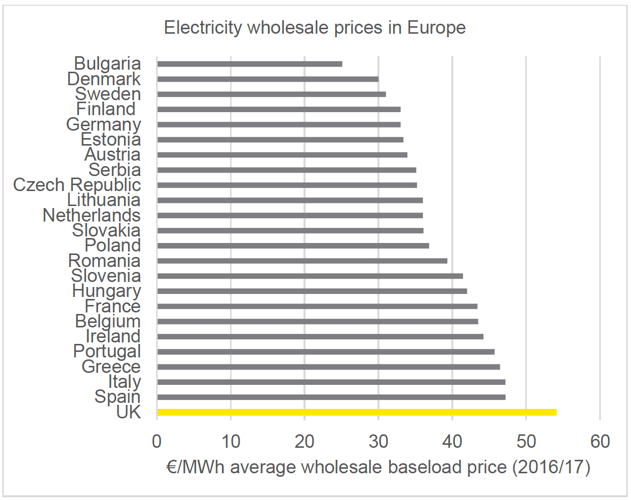
Source: Ofgem
Moreover whilst electricity prices are higher than the EU average, the two-tier nature of the UK energy market (with some customers switching regularly and others not switching at all) further exacerbates issues of energy affordability and fuel poverty. These problems are discussed in more detail below.
2.2.1 Fuel poverty in Scotland
In Scotland, domestic energy consumers are described as being fuel poor if they are required to spend more than 10% of their income on all household fuel use in order to maintain a satisfactory lifestyle, and described as extremely fuel poor if this is over 20%. A SG consultation on a new fuel poverty strategy, including a new definition of fuel poverty, closed on 1 February 2018 and responses to that will inform a Warm Homes Bill to be introduced later this year to set a new fuel poverty target.
The chart overleaf illustrates how the proportion of fuel poor domestic energy consumers in Scotland has evolved.
Figure 2 – Proportion of domestic energy consumers in fuel poverty and extreme fuel poverty and the fuel price index (2003-2016)
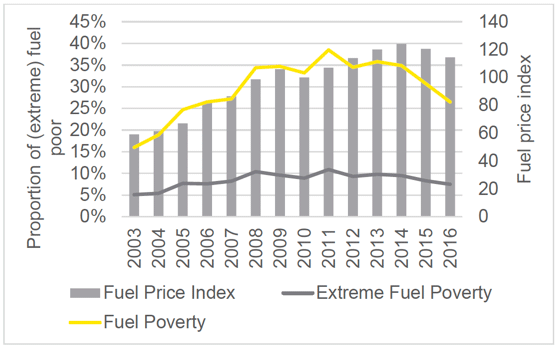
Source: Scottish Government (2016), Scottish House Condition Survey: 2015 Key Findings[10]
The proportion of domestic energy consumers in fuel poverty and extreme fuel poverty has, on average, increased between 2003 and 2016. The decline from 2014 resulted from a drop in fuel prices.
Many of those in fuel poverty are likely to be part of the significant group of consumers who do not regularly switch energy suppliers or who have never switched. Most of these will therefore be on a standard variable tariff, which for the majority of consumers will be the most expensive option. It is estimated that the average consumer on one of these tariffs would save over £300 per year by switching to a different supplier, or choosing a different tariff with the same supplier.[11]
In Scotland, households in rural and island areas are most likely to be in fuel poverty, while the largest cities (Aberdeen, Edinburgh and Glasgow) tend to have lower rates of fuel poverty. This is partly due to the housing stock in rural areas tending to be larger and harder to heat, as well as the higher likelihood of being off the gas grid (and so relying on higher-cost electrical or oil heating). Appendix A provides an analysis of Fuel Poor Households by Local Authority.
2.3 The opportunities for an Energy Co.
Given the problems identified in the energy market, there is clearly an opportunity for an Energy Co. if it could address some or all of these problems - to make a significant contribution to Scottish society and help to deliver on SG's energy strategy.
To do this the Energy Co. would need to be able to:
- Consistently provide competitive tariffs to attract and retain customers
- Help to reduce energy bills by reducing energy consumption e.g. by further supporting the roll-out of energy efficiency measures beyond the current interventions
- Encourage customers to switch suppliers by being perceived as a trustworthy brand that will continue to deliver competitive prices.
We explored whether the Energy Co. would be able to deliver these opportunities in practice in the following sections. Additionally, we have reviewed potential opportunities the Energy Co. may present by supporting economic development and growth.
2.4 Could an Energy Co. reduce energy costs?
Where new suppliers have been able to reduce the cost of energy, they have been successful at attracting those customers that are most engaged with the market (i.e. those most willing to switch provider for a lower price or higher level of service).
Price competitiveness is the single most common factor energy suppliers promote to try and attract customers, as shown by an assessment of the websites of the 42 domestic energy suppliers operating in Scotland (see Figure below).
Figure 3 – Features advertised to domestic consumers by energy suppliers in Scotland[12]
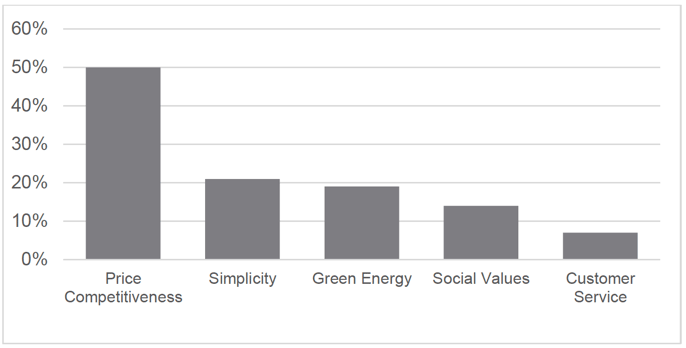
Source: Which? and EY analysis
The analysis highlights the following key messages:
- Half of the domestic energy suppliers in Scotland advertise low prices as a primary reason for why customers should choose to purchase their energy from them. Primarily, these offerings are in terms of being a cheaper alternative to the current tariff a customer is on elsewhere
- More than one out of five domestic energy suppliers in Scotland include some aspect of simplicity in their offering, either in the form of simple to understand tariffs, ease of switching to them, or tariffs with no exit fees. For example, Go Effortless Energy go by the slogan "honest, simple, fair".[13] Also, Ovo Energy advertise themselves as having "honesty and openness". For this they are advocating that tariffs and bills are easy to understand, pricing is transparent and there are no hidden rates or fees[14]
- Renewables are a focus for a number of the energy suppliers in Scotland, with it being a notable feature for approximately 19% of them. Green Energy and Good Energy have been specifically developed to supply clean energy to their customers.[15],[16] Good Energy has 71,000 electricity customers and 43,000 gas customers as of 2017 – suggesting some customers may value supplier attributes other than price. However, it is not possible to determine within this study whether these customers constitute a sustainable market as this will depend on the number of suppliers serving this market and their business models
- Social values, with the role the company is playing in the wider community, is a feature advertised to attract new domestic energy customers. This is seen as a selling point for 14% of the energy suppliers
- Good customer service is an attribute which only 7% advertise prominently. For many it is a minor point, but Green Network Energy is one of the few that make it a key point[17].
If the Energy Co. could provide competitive pricing (notwithstanding State Aid restrictions) it should be well positioned to attract customers. The pricing set by Energy Co do not need to be the lowest in the market to benefit customers who are currently disengaged from the market. The breadth of available market tariffs will also increase the opportunity to provide competitive pricing. To understand this further we consider the current performance of energy suppliers in the market and the cost of providing energy. Appendix B provides an understanding of the market context and regulatory requirements.
2.4.1 Performance of existing energy suppliers
The domestic energy supply market was opened to competition in 1998. Over time the number of suppliers competing in the market has increased and there are currently 42 active energy companies offering energy tariffs to domestic consumers in Scotland (See Appendix C for detail). The majority of these companies (81%) are currently supplying both gas and electricity, with six offering gas-only tariffs and only two offering electricity-only tariffs. This includes the 'Big 6' energy companies, and 36 small or medium sized suppliers.
Out of 42 domestic energy suppliers offering services in Scotland, approximately half recorded losses in their most recent financial statements, including two of the 'Big 6'. It is important to note, that many of these companies (excluding the 'Big 6') are in the early years of development therefore this is to be expected. Additionally, loss making domestic energy suppliers is a nationwide issue and not specific to Scotland. Of those that recorded a loss, 15 (over 70%) were incorporated after 2010. All, but one, of the loss making suppliers offer both gas and electricity. The margins suppliers expect from both gas and electricity is further discussed in the following section.
Two of the 'Big 6' supplier companies SSE and Npower, recently confirmed a merger. This transaction would reduce the 'Big 6' down to five (reference to the 'Big 6' in the remainder of this report recognises that this will become 'Big 5' in the future). The new organisation is expected to be roughly the size of market leader British Gas and serve 11.5 million customers. SSE the UK's second largest energy supplier, recently reported a decrease in pre-tax profits by 13.9%. The vision for the new firm is to be more agile, innovative and establish efficiencies that can be passed onto consumers. The merger demonstrates the constraints on even some of the larger suppliers in the market to remain profitable.
2.4.2 Supplier margins
Supplier pre-tax margins account for the profits for generators, network companies and suppliers. For the 'Big 6' dual-fuel energy bill, the pre-tax margin accounts for approximately 5% of the total household bill, with average margins for the 'Big 6' having risen significantly from 2009, as shown below. However, profits earned by the 'Big 6' have reduced during this period as they serve fewer customers and as households use less energy.
Figure 4 – Pre-tax domestic supply margins of large suppliers
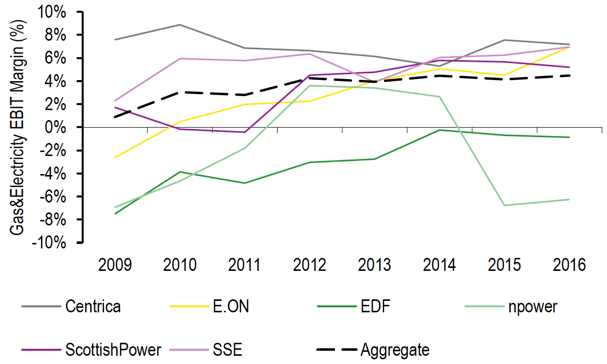
Source: Ofgem
Profit margins differ significantly across products and suppliers. In 2017, the pre-tax margins for the 'Big 6' providers were 11% for gas-only tariffs and -1% for electricity-only tariffs.
Moreover, margins for smaller suppliers tend to be significantly lower than those earned by the 'Big 6'. As illustrated in the figure overleaf, CMA analysis indicates that mid-tier suppliers had very mixed performance over the relevant period, with all of them making losses in at least one year and, in the years where they made profits, earnings before interest and tax (EBIT) margins of between 0.1% and 3.0%.
Figure 5 – EBIT margins for Mid-tier suppliers, FY09 to FY14
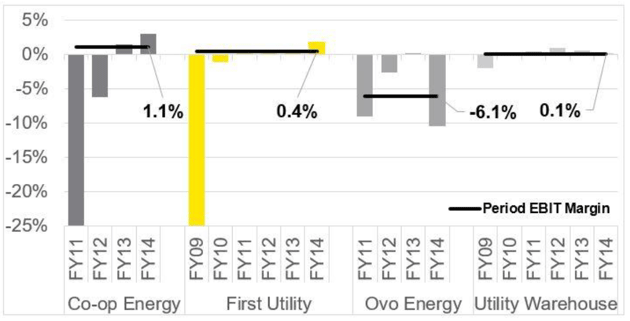
This difference in margins between the 'Big 6' and other suppliers highlights the difference in profit margins between customers on a Standard Variable Tariff (SVT) and those on fixed term deals. For instance, 64% of all domestic customers as of April 2017 were on a SVT, whereas this proportion is only 37% for customers not with non-Big 6 suppliers. Many of the customers with 'Big 6'suppliers are disengaged with the market – with approximately one third of customers having been on that supplier's SVT for at least three years.
This analysis indicates that, on average, supplier margins can be limited. This may present significant challenges to establishing a self-financing Energy Co. in a highly complex and competitive market.
2.4.3 Local energy generation and energy efficiency
The Energy Co. may also be able to achieve cost efficiencies through its objective of sourcing local energy generation. Energy bills for domestic energy customers include a number of elements, namely: the wholesale energy cost, the cost of transporting the energy via networks, social and environmental policy costs (as set out in the previous section), suppliers' own costs and margin and VAT.[18] The figure overleaf sets out the estimated proportions of these elements in an average gas and electricity bill.
Figure 6 – Estimated breakdown of an average gas and electricity bill for domestic energy consumers
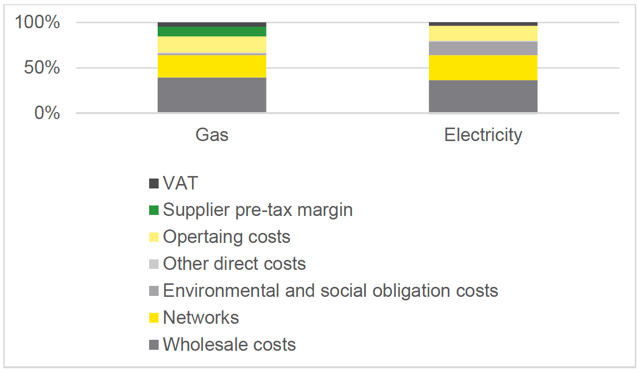
Source: Ofgem (2017), Breakdown of a gas bill/Breakdown of an electricity bill[19],[20]
Wholesale costs make up the biggest part of a typical energy bill (36%).[21] Wholesale costs include the fuel commodity costs, the additional carbon costs and taxes applied through the EU Emission Trading Scheme (ETS) and the UK Carbon Price Floor.
The second largest component of energy bills is network costs (26%). These are the costs recovered from suppliers to cover the maintenance of the distribution and transmission networks.
There is also the option to invest in generation, however this typically entails significant upfront cost and carries its own set of risks. Investors would require a rate of return on their investment that compensates them for these risks. Consequently, if the Energy Co. is willing to accept a lower rate of return (subject to State Aid restrictions) then it may be able to identify cost-effective options that would not be available to others.
2.5 Could an Energy Co. encourage energy efficiency more successfully than existing suppliers?
We have established how Energy Co. could seek to reduce the cost of energy for consumers, but there are other methods of reducing energy bills. A number of measures have been taken to try and promote energy efficiency as a way of reducing energy consumption among end users, particularly among the fuel poor.
Companies which promote energy efficiency include Energy Services Companies (ESCos). ESCos provide a commitment to deliver energy services to a specified level of performance and reliability. Activities can include financing, designing, building, operating and maintaining small-to-medium scale demand management and/or low carbon energy projects.[22] ESCos differ from the traditional model of energy suppliers, (whose role is to trade energy, and meter and bill their customers) as the ESCo's revenue stream is decoupled from customer consumption to some extent; this is particularly true for ESCos focusing on energy performance contracts where the ESCo is incentivised to reduce its customers' energy consumption.
ESCos are a growing feature of the energy retail landscape. For example, there are numerous companies providing energy services in the UK (at least 50 companies[23]), ranging from independent ESCos, e.g. Anesco and Ameresco, to utilities companies, e.g. British Gas and EDF, or LAs such as Birmingham District Energy or Thameswey Energy. The UK Energy Research Centre, identifies three broad models of ESCos in the market today:[24]
1. Commercial Model: This involves providing services as a way to retain large industrial customers on a long term supply contract. ESCos may also provide services as part of a facilities management approach to commercial and public sector buildings. Examples of this model include Anesco and British Gas
2. Community Model: ESCos are set up to serve a range of customers in the same locations, e.g. large housing developments, on a range of services such as design, build, finance, maintenance and billing. In this model, decisions are taken on behalf of a group of customers. Examples of this model include, Leicester District Energy Company and Birmingham District Energy
3. Domestic energy supplier model: In this model, ESCos (typically traditional energy suppliers in this case) provide services to domestic customers. This has so far proven to be the most difficult market to break into for ESCos. However, under the Energy Efficiency Commitment, micro generators play an important role in the offering that ESCos can provide to this market segment. Examples of this model include EDF.
A number of Local Authorities (LAs) in Scotland have established their own ESCos, including:[25]
- City of Edinburgh Council – Under the Climate Change (Scotland) Act 2009 public sector bodies, including LAs, are required to develop Carbon Management Plans as a key tool in tackling climate change and associated Sustainable Energy Action Plans (SEAP). The establishment of an ESCo is key to the delivery of a number of projects in Edinburgh Council's SEAP. Energy for Edinburgh's[26] key objectives include reducing carbon emissions, delivering affordable energy with a focus on alleviating fuel poverty, and encouraging wider community benefits.
- Aberdeen – In 2002 Aberdeen City Council set up Aberdeen Heat and Power (AHP)[27], which is a not-for-profit company that operates district heating and Combined Heat and Power (CHP) schemes in the area. In 2013, a wholly owned subsidiary, District Energy Aberdeen Ltd (DEAL), was established to enable commercial customers to be connected into the heat network. Any profits made are transferred back to the parent company to help offset more of the capital costs of developments to achieve affordable heat pricing and further the aims of reducing fuel poverty.
Many of these ESCos have focused on large industrial customers, but some have targeted domestic customers as well. If the Energy Co. were to adopt a similar strategy it may be able to help reduce energy bills more effectively than existing suppliers.
The Energy Co.'s socially-minded objectives would also make it more willing to invest in education programmes and work with customers to reduce energy consumption that could make its attempts to encourage energy efficiency and build a trusted brand more effectively.
2.6 Could an Energy Co. encourage customers to switch suppliers?
A significant driver of high energy prices and fuel poverty in Scotland is the lack of customer engagement in the existing energy market, with low rates of customers switching suppliers due to a lack of trust in the market.
Ofgem noted in its last Retail Energy Market report that Scotland has lower switching rates than the rest of GB; the switching rate in Scotland was 10% for electricity in 2015, compared to 12% across all of GB.[28]
This regional difference can also be seen in a survey by 'Which?' conducted this year. The survey found that 30% of 'Which?' members surveyed in North Scotland, and 18% in South Scotland, had never switched energy supplier, compared to 9%-18% in regions elsewhere in GB.[29] However, it is noted that the opportunity for consumers to switch in areas such as the North of Scotland may be more restricted due to a limited number of providers available.
Ofgem's 2017 State of the Energy Market report presented findings on the perceived risks of switching, presented below, which provides some insight into why customers may not switch.
Figure 7 – Perceived risks of switching
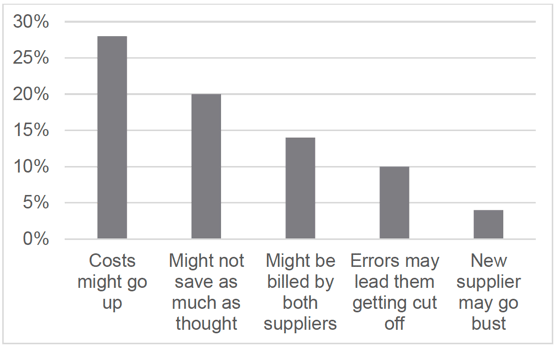
Source: Ofgem[30]
Ofgem has also identified a number of consumer biases that are likely acting as impediments to consumers' decisions to switch provider even where there are significant bill savings to be made from doing so. These biases include: limited consumer capacity - consumers encounter difficulties in decision making when faced with a large number of options and significant information about each of them. This can lead them both to make sub-optimal decisions and to not seek out the most relevant information.
- Status quo bias – consumers place extra value on what they already have. This coupled with the ease of staying with the current supplier can lead to significant number of customers never switching supplier
- Loss aversion – consumers attach more weight to possible monetary losses than the same monetary gain. This has implications in markets with a lot of choice, not only do they prefer what they have, the possibility of losing if they move would need to be significantly outweighed by any potential overall benefit. For example, even if a consumer could see a financial benefit in switching they may not be willing to take the risk that customer service may be slightly worse
- Time inconsistency – consumers have a preference for immediate returns rather than considering the longer term outlook. This suggests that 'teaser rates', where customers are lured in with savings in the short term even with higher rates in the long term, could be used to attract customers. It is suggested that this bias can put people off fixed rate deals that are more beneficial in the longer term.
Consumer biases can result in consumers not behaving 'rationally', i.e. not making decisions that are in their best interests. Without this challenge, there is no incentive for larger profitable companies to reduce their tariffs. There are existing socially minded suppliers in the market who are focused on promoting their social values as a way of engendering trust amongst customers and encouraging them to switch their energy supply. These suppliers may typically owned by a LA or housing provider. Examples of socially minded suppliers include Bristol Energy, Robin Hood Energy and Our Power. These suppliers aim to provide energy to customers at lower prices by;
- Not paying dividends to shareholders
- Finding more efficient ways to operate
- Generating their own power
- Reinvesting any profits to further benefit customers and their communities.
As many of the socially minded suppliers are relatively new to the market, it is not yet apparent how sustainable these lower prices are or to what extent these suppliers have been able to reduce costs. Each have reported losses, £7.7m in 2017 for Bristol Energy,[31] £2.5m in 2016 for Robin Hood Energy,[32] and £0.9m for Our Power in 2015.[33]
2.7 Could an Energy Co. support economic development and economic growth?
SG's purpose, as set out in Scotland's Economic Strategy, is to create a more successful country, with opportunities for all, by increasing sustainable economic growth.
An objective of the Energy Co. is to deliver competitively priced energy. In doing so it seeks to provide energy customers with more choice, particularly for those where fuel poverty is a key concern.
On successful implementation an Energy Co. has the potential to:
- support sustainable economic growth by supporting local energy generation and energy efficiency
- delivering a lower cost of capital for supplying energy to Scottish customers
- encouraging energy efficiency more successfully than existing suppliers
- inspiring customers to switch suppliers.
Energy Co.'s not-for-profit status may, in time, result in lower energy prices and bills (subject to minimal consumer substitution effects). Whilst this may have an adverse impact on industry margins and finance availability within the energy sector supply chain, it would be expected to support real disposable incomes for energy users across Scotland. Depending on patterns of spend and household or business types, this transmission mechanism could provide net economic support to wider activity across the Scottish economy.
Any economic impact will not be driven solely by the potential reductions in the price of energy, but also, in time, by reductions in energy bills through enhanced energy efficiency. This could play a critical enabling role in any resulting economic impact. For example, a net socio-economic return may be realised by encouraging increased levels of energy efficiency amongst energy users more successfully than existing energy suppliers.
Analysis undertaken by the University of Strathclyde International Public Policy Institute's Centre for Energy Policy suggests that greater energy efficiency amongst low income households could lead to a sustained uplift in Scottish GDP, employment and public finances.[34] The key transmission mechanism, in terms of fuel poverty, is that not only will spending on energy by low income households fall, the purchasing power of low household real incomes could rise in a sustained manner.
The availability of energy suppliers differs across Scottish geographies (for example, northern Scotland, where there are currently more limited numbers of suppliers in the market). This results in limited levels of competition in some areas. The introduction of the Energy Co. and the resulting increase in the choice of suppliers, lower energy prices and the potential ability to improve the provision of competitive offers from suppliers, could alter the competitive landscape across some geographies, subject to existing network constraints and charges. This, coupled with other improvements in the access to and cost of other utilities (e.g. broadband), means the Energy Co. has the potential to further impact potential productive capacities in more rural regions in Scotland. This may encourage additional investment and economic activity.
As a market innovation, the Energy Co. has the potential to support a number of Scotland's Economic Strategy pillars, namely: Investment, Innovation and Inclusive Growth. A quantified estimate of the potential economic impact has not been undertakes at the SOC stage. However, we recommend that further analysis be undertaken at OBC stage to consider the potential economic impact of each of the short-listed options in more detail.
2.8 Energy Co. objectives
Noting the problems in the Scottish energy market and opportunities for the Energy Co. to positively address some or all of those problems, the objectives of the Energy Co. can be summarised as follows:
- Deliver competitively priced energy which will, among other things, help to alleviate fuel poverty
- Promote locally sourced renewable energy in the medium to long term
- Be publicly owned and will be operated on a not-for-profit basis (either explicitly, or de facto and subject to State Aid restrictions, with a commitment to re-invest any surplus or profits)
- Support growth of the Scottish Economy.
2.9 Remit
In order to translate the objectives of the Energy Co. into specific activities that it would engage in, we have made the following assumptions:
- The Energy Co.'s priority will be to provide low cost energy to help alleviate fuel poverty. This is followed by the secondary objective of sourcing energy locally and from renewable sources
- Depending on the chosen operating model, there may be a need for the Energy Co. to operate actively in the energy wholesale and retail markets. This will require an appropriate supply licence
- There are certain activities that are unlikely to be part of the Energy Co. remit at start up stage, but there is a commitment to retaining flexibility to allow the company to respond to changes in the wider energy market
The Energy Co.'s initial objectives are to help to alleviate fuel poverty by providing competitively priced energy. This, however, is not limited to domestic consumers and could look to incorporate non-domestic consumers.
The remit of the Energy Co. has been categorised into three sections. The activities for each phase have been detailed below.
- Remit for Phase 1 – establish capability and strategy:
- Acquire energy at competitive prices and pass onto customers at lowest possible costs, for example a mark-up to cover overhead only
- The primary focus would be supply of electricity and gas
- Incorporate price information and / or assisting in changing supplier to the Energy Co.
- Remit for Phase 2 – medium term (subject to successful delivery of Phase 1):
- Increase proportion of energy from renewable sources
- Incorporate other forms of energy supply, e.g. district heating
- Provision of energy efficiency measures.
- Remit for Phase 3 – long term:
- Increase to offer other utility services, such as broadband, as part of product offer to consumers
- Potential to participate in energy generation by investing in renewable energy projects.
The remaining sections of the SOC explore the potential delivery structures for the Energy Co., review the financial and commercial considerations for the Energy Co. and discuss how these would be further explored at the OBC stage.
2.10 Conclusions
The Strategic Case demonstrates that the Energy Co. could be successful in addressing some of the problems in Scotland's energy market, including alleviating fuel poverty. In summation it could begin to resolve the issues through:
- Reducing energy costs
- The Energy Co. will be not-for-profit, it won't charge a profit margin on its activities and will only be required to cover its costs. The analysis indicates that there is little to no margin on the sale of electricity, however the sale of gas is more profitable. The OBC will analyse further whether it would be possible for the Energy Co. to provide energy at competitive prices and remain self-financing by reviewing this in more detail.
- The pricing set by Energy Co do not need to be the lowest in the market to benefit customers who are currently disengaged from the market.
- The Energy Co. would look to optimise the supply and demand of locally sourced energy to reduce the cost of delivering energy.
- Encouraging energy efficiency more successfully than existing suppliers
- Consumers may be more likely to trust the Energy Co. brand, which would enable it to roll out energy efficiency measures where others have not been successful. The Energy Co.'s socially-minded objectives could also facilitate investment in education programmes and working with customers to reduce energy consumption.
- Encouraging customers to switch suppliers
- An Energy Co., as a public sector initiative, may be able to build a greater and more positive brand awareness and could leverage the extensive media outlets available to the public sector to communicate with a number of disengaged customers that would otherwise have remained with an uncompetitive tariff.
- The Energy Co would also need to recognise that it would need to be continually competitive in the marketplace to ensure that they are able to retain customers who have switched.
- Supporting economic development
- Energy Co. has the potential to support a number of Scotland's Economic Strategy pillars, namely: Investment, Innovation and Inclusive Growth.
Contact
Email: Alan.Clark@gov.scot
There is a problem
Thanks for your feedback